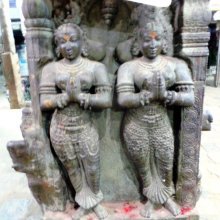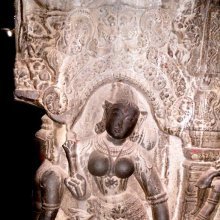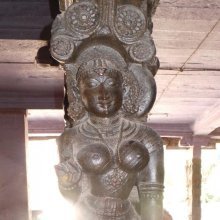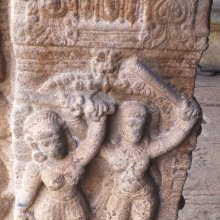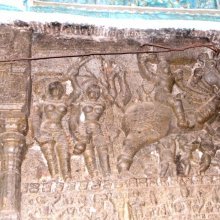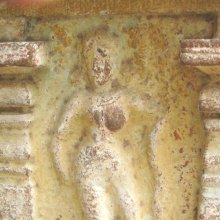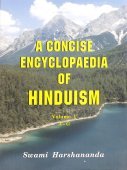Dashi, Daśi, Dāsī, Dasi, Dāsi, Dâshi, Dasī: 21 definitions
Introduction:
Dashi means something in Buddhism, Pali, Hinduism, Sanskrit, the history of ancient India, Marathi, Jainism, Prakrit, Hindi, biology. If you want to know the exact meaning, history, etymology or English translation of this term then check out the descriptions on this page. Add your comment or reference to a book if you want to contribute to this summary article.
The Sanskrit term Daśi can be transliterated into English as Dasi or Dashi, using the IAST transliteration scheme (?).
Images (photo gallery)
(+13 more images available)
In Hinduism
Dharmashastra (religious law)
Source: Wisdom Library: Dharma-śāstraDaśi (दशि) refers to the person in charge of Ten villages. The word is used throughout Dharmaśāstra literature such as the Manusmṛti. (See the Manubhāṣya verse 7.119)
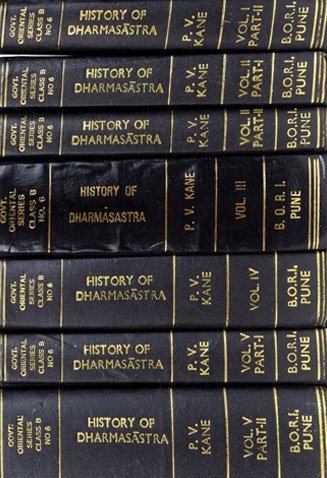
Dharmashastra (धर्मशास्त्र, dharmaśāstra) contains the instructions (shastra) regarding religious conduct of livelihood (dharma), ceremonies, jurisprudence (study of law) and more. It is categorized as smriti, an important and authoritative selection of books dealing with the Hindu lifestyle.
Purana and Itihasa (epic history)
Source: archive.org: Puranic EncyclopediaDāsī (दासी).—An important river in India. (Mahābhārata Bhīṣma Parva, Chapter 9, Verse 31).
Source: Cologne Digital Sanskrit Dictionaries: The Purana Index1a) Dāsi (दासि).—Slaves as present to learned men.*
- * Brahmāṇḍa-purāṇa II. 34. 39.
1b) Of four kinds, devadāsi, brahmadāsi, svatantra and śūdradāsika; the first two occupy the status of a Kṣatriya lady; the third enjoys the status of a dancing girl (veśi), and the last that of a low caste (hīnajāti).1 A synonym of Paricārika or a servant-maid.2
Source: JatLand: List of Mahabharata people and placesDāsī (दासी) refers to the name of a River mentioned in the Mahābhārata (cf. VI.10.30). Note: The Mahābhārata (mentioning Dāsī) is a Sanskrit epic poem consisting of 100,000 ślokas (metrical verses) and is over 2000 years old.

The Purana (पुराण, purāṇas) refers to Sanskrit literature preserving ancient India’s vast cultural history, including historical legends, religious ceremonies, various arts and sciences. The eighteen mahapuranas total over 400,000 shlokas (metrical couplets) and date to at least several centuries BCE.
Vaishnavism (Vaishava dharma)
Source: Pure Bhakti: Bhajana-rahasya - 2nd EditionDāsī (दासी) refers to:—A maidservant. (cf. Glossary page from Bhajana-Rahasya).
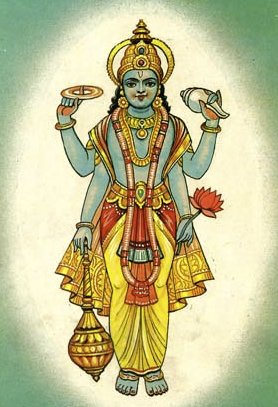
Vaishnava (वैष्णव, vaiṣṇava) or vaishnavism (vaiṣṇavism) represents a tradition of Hinduism worshipping Vishnu as the supreme Lord. Similar to the Shaktism and Shaivism traditions, Vaishnavism also developed as an individual movement, famous for its exposition of the dashavatara (‘ten avatars of Vishnu’).
Ayurveda (science of life)
Nighantu (Synonyms and Characteristics of Drugs and technical terms)
Source: WorldCat: Rāj nighaṇṭuDāsī (दासी) is another name for Kākajaṅghā, an unidentified medicinal plant possibly identified with either Peristrophe bicalyculata Nees (Masī) or Leea aequata Linn. syn. Leea hirta Roxb. ex Hornem., according to verse 4.142-143 of the 13th-century Raj Nighantu or Rājanighaṇṭu. The fourth chapter (śatāhvādi-varga) of this book enumerates eighty varieties of small plants (pṛthu-kṣupa). Together with the names Dāsī and Kākajaṅghā, there are a total of seven Sanskrit synonyms identified for this plant.

Āyurveda (आयुर्वेद, ayurveda) is a branch of Indian science dealing with medicine, herbalism, taxology, anatomy, surgery, alchemy and related topics. Traditional practice of Āyurveda in ancient India dates back to at least the first millenium BC. Literature is commonly written in Sanskrit using various poetic metres.
In Buddhism
Mahayana (major branch of Buddhism)
Source: academia.edu: A Study and Translation of the GaganagañjaparipṛcchāDāsī (दासी) refers to “female servants”, according to the Gaganagañjaparipṛcchā: the eighth chapter of the Mahāsaṃnipāta (a collection of Mahāyāna Buddhist Sūtras).—Accordingly: “Then the Bodhisattva Apāyajaha addressed himself to the Bodhisattva Gaganagañja: ‘Son of good family, please pacify three evil existences’. [...] Then, the rain of gifts, such as flowers, garlands, incenses, unguents, aromatic powers, religious robes, parasols, banners, pennons, five kinds of musical instruments, songs, male servants, female servants (dāsī), wives, boys, girls, female attendants, horses, elephants, [...] poured down from the open space. [...]”.

Mahayana (महायान, mahāyāna) is a major branch of Buddhism focusing on the path of a Bodhisattva (spiritual aspirants/ enlightened beings). Extant literature is vast and primarely composed in the Sanskrit language. There are many sūtras of which some of the earliest are the various Prajñāpāramitā sūtras.
India history and geography
Source: Cologne Digital Sanskrit Dictionaries: Indian Epigraphical GlossaryDāsī.—(CITD), a handmaid, slave, concubine, dancing girl. Note: dāsī is defined in the “Indian epigraphical glossary” as it can be found on ancient inscriptions commonly written in Sanskrit, Prakrit or Dravidian languages.

The history of India traces the identification of countries, villages, towns and other regions of India, as well as mythology, zoology, royal dynasties, rulers, tribes, local festivities and traditions and regional languages. Ancient India enjoyed religious freedom and encourages the path of Dharma, a concept common to Buddhism, Hinduism, and Jainism.
Biology (plants and animals)
Source: Google Books: CRC World Dictionary (Regional names)Dashi in Niger is the name of a plant defined with Commiphora africana in various botanical sources. This page contains potential references in Ayurveda, modern medicine, and other folk traditions or local practices It has the synonym Balsamea pilosa Engl. (among others).
Example references for further research on medicinal uses or toxicity (see latin names for full list):
· Journal of Ethnopharmacology (2005)
· Fitoterapia (2008)
· Journal of Ethnopharmacology (2004)
· Journal of Ethnopharmacology (2006)
· Journal of Ethnopharmacology (1987)
· Florae Senegambiae Tentamen (1831)
If you are looking for specific details regarding Dashi, for example pregnancy safety, diet and recipes, chemical composition, health benefits, side effects, extract dosage, have a look at these references.

This sections includes definitions from the five kingdoms of living things: Animals, Plants, Fungi, Protists and Monera. It will include both the official binomial nomenclature (scientific names usually in Latin) as well as regional spellings and variants.
Languages of India and abroad
Pali-English dictionary
Source: BuddhaSasana: Concise Pali-English Dictionarydāsī : (f.) a female slave.
Source: Sutta: The Pali Text Society's Pali-English DictionaryDāsī, (f.) (Sk. dāsī, cp. dāsa. Nom. pl. dasso for dāsiyo J.IV, 53; in cpds. dāsi°) a female servant, a handmaiden, a slave-girl Vin.I, 217, 269, 291; II, 10 (kula°), 78= III, 161; M.I, 125; II, 62 (ñāti°); Pv.II, 321 (ghara°); PvA.46, 61, 65.—Cp. kumbha°.

Pali is the language of the Tipiṭaka, which is the sacred canon of Theravāda Buddhism and contains much of the Buddha’s speech. Closeley related to Sanskrit, both languages are used interchangeably between religions.
Marathi-English dictionary
Source: DDSA: The Molesworth Marathi and English Dictionarydaśī (दशी).—f (daśā S) An end or unwoven thread of a cloth. Commonly used pl daśā (the thrum). Pr. kāmbaḷyācī daśī āṇi pāsōḍyā aiśī. Pr. sadaivācī daśī naradēvācā pālava (lāgāvā &c.) daśī vāhaṇēṃ To throw an end or unwoven thread of cloth at the new moon. A rite to obtain new clothes.
--- OR ---
dāsī (दासी).—f (S) A female slave or servant. 2 The wife of a Shudra.
Source: DDSA: The Aryabhusan school dictionary, Marathi-Englishdaśī (दशी).—f An end or unwoven thread of a cloth.
--- OR ---
dāsī (दासी).—f A female slave or servant.
Marathi is an Indo-European language having over 70 million native speakers people in (predominantly) Maharashtra India. Marathi, like many other Indo-Aryan languages, evolved from early forms of Prakrit, which itself is a subset of Sanskrit, one of the most ancient languages of the world.
Sanskrit dictionary
Source: DDSA: The practical Sanskrit-English dictionaryDāsī (दासी).—
1) A female servant or slave.
2) The wife of a fisherman.
3) The wife of a Śūdra.
4) An altar.
5) A harlot.
Source: Cologne Digital Sanskrit Dictionaries: Monier-Williams Sanskrit-English Dictionary1) Dāśī (दाशी):—[from dāśa > dāś] f. fisher-woman, female slave, [cf. Lexicographers, esp. such as amarasiṃha, halāyudha, hemacandra, etc.]
2) Dāsī (दासी):—[from dāsa > dās] a f. a female servant or slave, [Atharva-veda; Śatapatha-brāhmaṇa; Manu-smṛti; Mahābhārata] etc.
3) [v.s. ...] harlot, [cf. Lexicographers, esp. such as amarasiṃha, halāyudha, hemacandra, etc. [Scholiast or Commentator]]
4) [v.s. ...] Name of a plant (= nilā or pītā jhintī, kāka-jaṅghā, nīlāmlāṇa etc.), [cf. Lexicographers, esp. such as amarasiṃha, halāyudha, hemacandra, etc.]
5) [v.s. ...] an altar, [cf. Lexicographers, esp. such as amarasiṃha, halāyudha, hemacandra, etc.]
6) [v.s. ...] Name of a river, [cf. Lexicographers, esp. such as amarasiṃha, halāyudha, hemacandra, etc.]
7) [from dās] 2. dāsī (also sīka ifc.) f. of 1. dāsa (q.v.).
Source: DDSA: Paia-sadda-mahannavo; a comprehensive Prakrit Hindi dictionary (S)Dāsī (दासी) in the Sanskrit language is related to the Prakrit word: Dāsī.
[Sanskrit to German]
Sanskrit, also spelled संस्कृतम् (saṃskṛtam), is an ancient language of India commonly seen as the grandmother of the Indo-European language family (even English!). Closely allied with Prakrit and Pali, Sanskrit is more exhaustive in both grammar and terms and has the most extensive collection of literature in the world, greatly surpassing its sister-languages Greek and Latin.
Hindi dictionary
Source: DDSA: A practical Hindi-English dictionary1) Daśī (दशी):—(nf) a decade, decennium.
2) Dāsī (दासी):—(nf) a maid-servant; a slave girl.
...
Prakrit-English dictionary
Source: DDSA: Paia-sadda-mahannavo; a comprehensive Prakrit Hindi dictionaryDāsī (दासी) in the Prakrit language is related to the Sanskrit word: Dāsī.
Prakrit is an ancient language closely associated with both Pali and Sanskrit. Jain literature is often composed in this language or sub-dialects, such as the Agamas and their commentaries which are written in Ardhamagadhi and Maharashtri Prakrit. The earliest extant texts can be dated to as early as the 4th century BCE although core portions might be older.
Kannada-English dictionary
Source: Alar: Kannada-English corpusDasi (ದಸಿ):—
1) [noun] a length of wood or metal, pointed at one end for driving into the ground as a boundary mark, part of a fence, support for a plant, etc.; a stake; a heavy peg.
2) [noun] a piece of wood, metal, etc., usu. long and square or cylindrical, set upright to support a building, sign, fence, etc.; a post.
3) [noun] a short, hard, leafless, pointed part of some plants; a thorn.
4) [noun] a kind of arrow.
--- OR ---
Dāsi (ದಾಸಿ):—
1) [noun] a female servant esp. slave.
2) [noun] a woman who has sexual relations with a man without being married to him; a mistress; a courtesan.
3) [noun] the prickly plant Barleria polytricha of Acanthaceae family.
4) [noun] its flower.
Kannada is a Dravidian language (as opposed to the Indo-European language family) mainly spoken in the southwestern region of India.
See also (Relevant definitions)
Starts with: Dashin, Dashishi, Dashivala, Dashivams, Dashivas, Dashividarbha, Dasika.
Ends with (+110): Advaitapancadashi, Anandacaturdashi, Anangadvadashi, Anangatrayodashi, Anantacaturdashi, Anantachaturdashi, Aranyadvadashi, Ashokadvadashi, Bhedashi, Bhimadvadashi, Bhimaikadashi, Bhimaseni Ekadashi, Bhutacaturdashi, Bhutachaturdashi, Bondashi, Caitradvadashi, Campakacaturdashi, Caturdashi, Chaitradvadashi, Champakachaturdashi.
Full-text (+130): Ghatadasi, Dasisabha, Dasheya, Dasitva, Dasidasa, Dasadasi, Kumbhadasi, Dasa, Dasiputra, Dasika, Caturdashi, Dasishrotriya, Dasisuta, Trayodashi, Panyadasi, Viharadasi, Devadasi, Dasyahputra, Grihadasi, Namijin dashi.
Relevant text
Search found 43 books and stories containing Dashi, Daasi, Dâshi, Daśi, Dāsī, Dasi, Dāsi, Daśī, Dāśī, Dasī; (plurals include: Dashis, Daasis, Dâshis, Daśis, Dāsīs, Dasis, Dāsis, Daśīs, Dāśīs, Dasīs). You can also click to the full overview containing English textual excerpts. Below are direct links for the most relevant articles:
Manusmriti with the Commentary of Medhatithi (by Ganganatha Jha)
Verse 7.119 < [Section X - Internal Administration]
Verse 11.183 < [Section XX - Expiation for associating with Outcasts]
Verse 3.9 < [Section III - Marriageable Girls]
Rig Veda (translation and commentary) (by H. H. Wilson)
Tattvartha Sutra (with commentary) (by Vijay K. Jain)
Verse 7.29 - The transgressions of the minor vow of limiting possessions < [Chapter 7 - The Five Vows]
Kathasaritsagara (the Ocean of Story) (by Somadeva)
Sanskrit sources of Kerala history (by Suma Parappattoli)
The Paliyam Palates of Varaguna < [Chapter 1 - Historical details from Sanskrit Inscriptions]
5.4. Syanandurapuravarnana-samuccaya < [Chapter 2 - Historical details from Mahatmyas and Prashastis]
Bhajana-Rahasya (by Srila Bhaktivinoda Thakura Mahasaya)
Text 11 < [Chapter 5 - Pañcama-yāma-sādhana (Aparāhna-kālīya-bhajana–kṛṣṇa-āsakti)]
Text 21 < [Chapter 8 - Aṣṭama-yāma-sādhana (Rātri-līlā–prema-bhajana sambhoga)]
Related products
